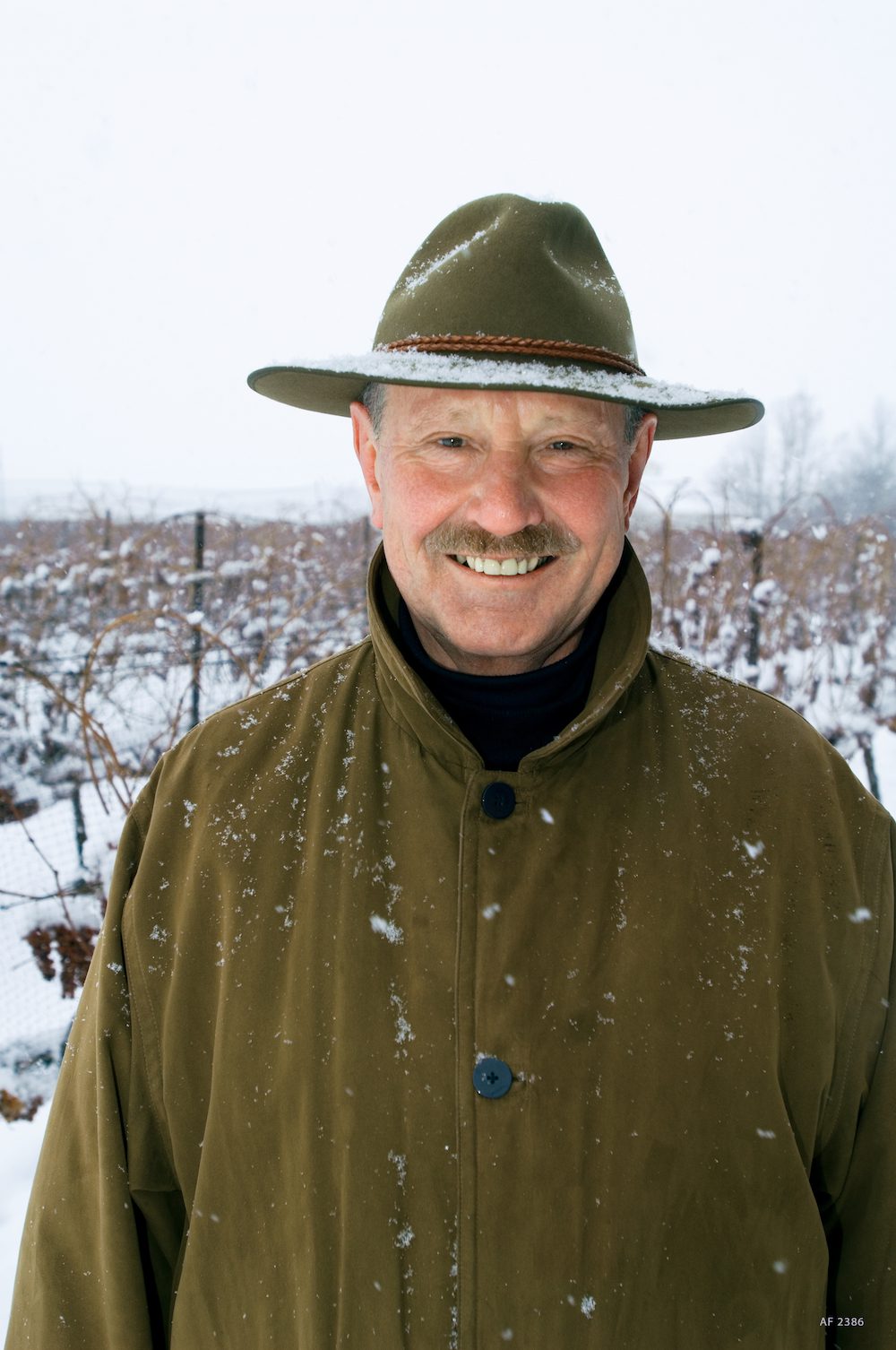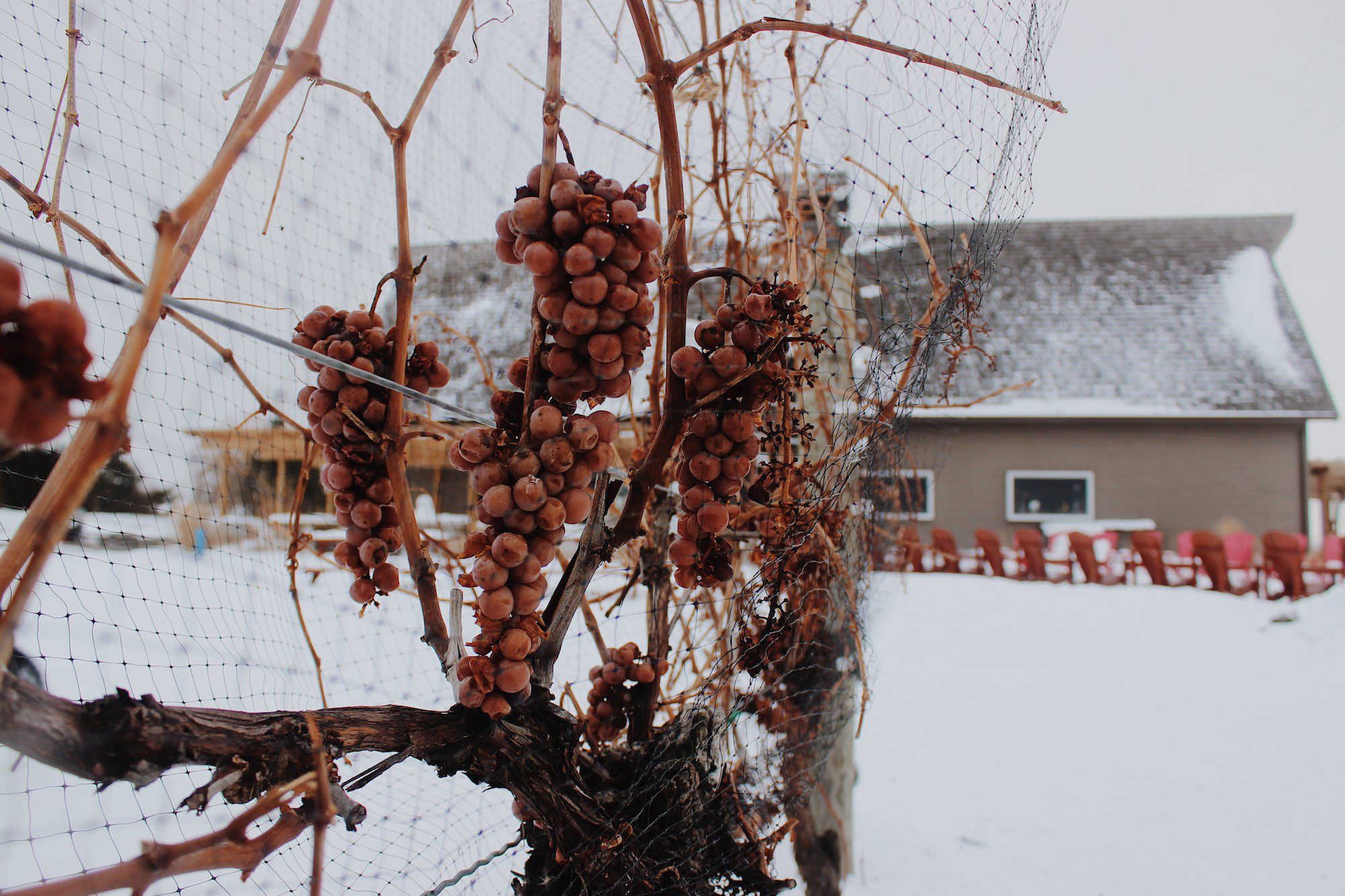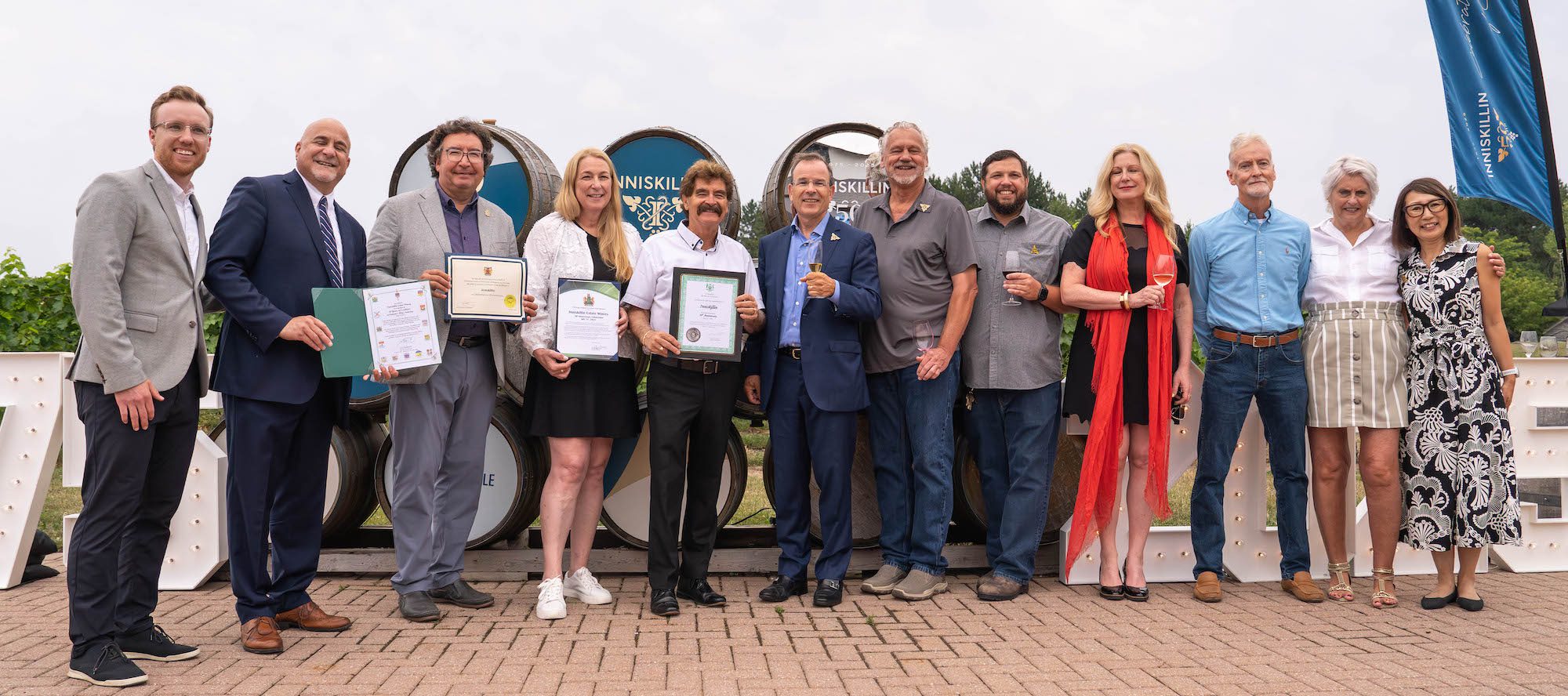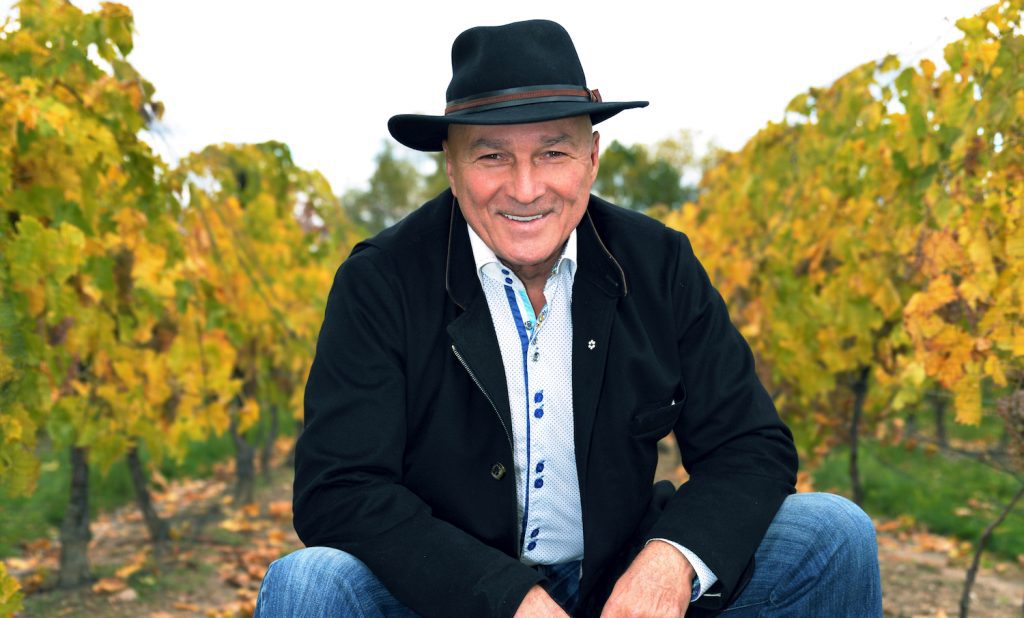Chuck Buyers immerses himself in the annals of Inniskillin, which this year celebrated its golden anniversary, having initially wowed many with its Vidal Icewine of that very colour, and then with plenty more. Not bad for an idea many once scoffed at.
“This cannot work! What a stupid and ridiculous idea! Growing premium vines and – Vinifera to boot – in Ontario? They’ll never get it off the ground!” The sceptics were many when the idea of growing premium grapes in Niagara-on-the-Lake was announced by two visionaries, who believed that top quality wine could be made in Ontario – but they did it. Donald J. P. Ziraldo and Karl Kaiser succeeded in spite of all the naysayers.
Donald Ziraldo was born in St. Catharine’s, Ontario, on October 13, 1948. In 1971, he graduated from the University of Guelph with a Bachelor of Science degree in Agriculture and took over the family nursery business. Ziraldo became interested in, and learned how to, graft vines while doing research in Italy. He was puzzled that Vitis vinifera vines were grown in cold climate areas in Europe but not in Canada (Ontario).
Local grape growers including government research stations all refused to believe that grafted viniferous vines could be grown – pointing to rows of dead Riesling vines present. In 1974, he purchased the Jefferies Farm (now Seeger Vineyard) and grafted 30,000 vines (Riesling, Chardonnay and Gamay).
Enter Karl Kaiser!
 Kaiser (Sept. 22, 1941-Nov. 22, 2017) was not a fan of the wine he initially tasted in Ontario. He was Austrian and knew good wine – having been educated at Stift Klosterneuburg, a historical 900-year-old abbey near Vienna, which among many things, is one of Austria’s oldest wine estates and a religious/cultural centre with a wine cellar that goes down some 35 metres (105 feet) below ground level. It also has the original footings for a Roman building still visible! Furthermore, Kaiser was also an experienced home winemaker.
Kaiser (Sept. 22, 1941-Nov. 22, 2017) was not a fan of the wine he initially tasted in Ontario. He was Austrian and knew good wine – having been educated at Stift Klosterneuburg, a historical 900-year-old abbey near Vienna, which among many things, is one of Austria’s oldest wine estates and a religious/cultural centre with a wine cellar that goes down some 35 metres (105 feet) below ground level. It also has the original footings for a Roman building still visible! Furthermore, Kaiser was also an experienced home winemaker.
Upon moving to St. Catharine’s, Ontario, in 1969, Kaiser got together with Ziraldo to purchase some vines. He made some wine which pleased Ziraldo and a partnership was formed. Karl enrolled in Brock University and in 1974 graduated with a Bachelor of Science degree in Chemistry and Biochemistry.
Two men who were more diverse one could not find, according to Debi Pratt, who, in her own right, was an integral part of Inniskillin’s success from the outset. Debi looked after public relations, hospitality, sales and tourism, and is now retired. She commented in a prior interview; “Ziraldo and Kaiser were complete opposites. Karl was content to be just at the winery, while Ziraldo took centre stage during the early years but gradually became more active in the front lines.”
Ziraldo himself admitted in a ‘Grape Growers Of Ontario’ article that working with an artist such as Kaiser could be “difficult to deal with” but that, “He was an artist and artists are like that! They are just temperamental and creative.” Kaiser wanted to start selling right away but more work had to be done first!
An uphill battle
With the exception of a few wineries, wines were made from Vitis labrusca vines. These were native grapes that were highly resistant to diseases that would overwhelm those of a Vitis vinifera origin. However, Vitis labrusca could not develop the wine quality of the European viniferous vines. Eventually, hybrid grapes began to be produced which emulated Vitis vinifera wines but still did not reach the same quality level.
Ziraldo and Kaiser fought an uphill battle with sceptics and bureaucracy, until in 1974, the head of the Liquor Control Board of Canada issued a provisional license to produce wine to be sold at the Rare Wine Store in Toronto. The Vitis vinifera vines planted by Ziraldo served their purpose and gave Kaiser the material to work with. On July 31, 1975, the Inniskillin Winery was granted a permanent licence by Major General George Kitching, the head of the Liquor Control Board of Ontario. The winery was named Inniskillin, in honour of the property’s original owner, Regimental Commander Cooper of the Inniskilling Fusiliers.
Strutting its stuff
With his genius mentality Karl Kaiser proved that excellent wine could be made at Inniskillin. Now it was time to show the doubters around Canada and the rest of the world. Donald Ziraldo took on the humongous task with so much depending on him. Showing that your product can compete with other wine made in other countries is tough enough for willing participants but trying to persuade those who have already preconceived ideas that your wine “can’t be any good” required a person of deep commitment and also belief in both himself, his partners and his product. He showed he had it in him to do all that and more.
Marketing Inniskillin
Once the license was given, the hardest job was to change people’s perception of this new fledgling winery. Donald Ziraldo put his vast, almost limitless energy to great use in the form of tastings, media usage and world travel.
Inniskillin’s reputation started to rise as it held its own and surpassed competing wines at tastings. At one tasting hosted by the Globe and Mail newspaper, a 1974 Marechal Foch from Inniskillin beat a 1973 Chateau de la Ferriere Bareilly 1973 from Beaujolais.* The tasters were so surprised that they retested and proved the score correct. Another ‘feather’ in Inniskillin’s cap was when, in 1982, there was a sale of 650 cases of 1980 Inniskillin Marechal Foch sold to a Burgundy wine house, F. Chauvenet. This caused quite a stir but unfortunately the elation was short lived since “The media release was pulled out of the media kit by the French trade office in Toronto because Canada does not have an Appellation System and therefore wines could not be shipped to the EU!…the shipment sat there for many years while we formulated VQA (Vintners Quality Alliance) as a voluntary organization in Ontario and BC.”
Ziraldo, along with government officials, attended OIV symposiums governing wine, viticulture and appellations. This would have stopped a lesser individual but instead it acted as a catalyst for the establishing of a Canadian Appellation System. Donald Ziraldo picked up the gauntlet and was the driving force behind the Vintners Quality Alliance in Ontario and British Columbia. Ziraldo’s present focus is to have a National VQA appellation system for the whole of Canada.
Icewine breakthrough
There was a time when Icewine was attributed to countries such as Germany and Austria, where the luscious sweet wine was made from naturally frozen grapes. The same process for making Icewine was the one deployed at Inniskillin using the hybrid Vidal Blanc grape. Vidal Blanc, developed for Cognac production in the 1930s by Jean Louis Vidal, is a thick-skinned, disease-resistant and winter-hardy grape that is well-suited for the harsh Canadian winter. It is the only hybrid that can be considered by the OIV to make Icewine under the VQA regulations. To make Icewine, the grapes are left on the vine well past the harvest dates until the winter cold freezes at -8°C as per VQA regulations. The grapes are then harvested and immediately crushed. The resulting wine is renowned worldwide.
Ziraldo and Kaiser’s first attempt at making Icewine was in 1983. The story goes that Ziraldo came over to the vineyard and asked Kaiser if they had already harvested since there were no grapes on the vines. Aghast, Kaiser replied in the negative and both went to the vineyard to fine bare vines. Birds and other creatures had dined well that week!
Netting and other protective devices ensured that the first Icewine harvest of 1984 was picked intact.
Other than the positive thoughts of Ziraldo and Kaiser, no one would have thought that Inniskillin Icewine would succeed. However in 1991, the 1989 VQA Inniskillin Vidal Icewine won the ultimate prize of Grand Prix d’Honneur at VinExpo in Bordeaux, France. Ontario wine and Canada were now on the world wine map and have moved forward ever since.

Moving ahead: a new location and vineyards
A major move saw Inniskillin switching its original location to the then 30-acre Brae Burn Estate, in 1978, and adding another 50 acres by the purchase of the Montague Vineyard in 1982 (supplemented with a further 50 acres in 1991). Brae Burn is Gaelic for ‘Hill Stream’, referring its location next to the Niagara River and Niagara Escarpment. The barn located on the property, built in the 1920s, is reputed to have been inspired by Frank Lloyd Wright (June 1867-April 1959), who was world famous for his building designs.
The 1990s saw Inniskillin moving further ahead, with the establishment of a venture with the Inkameep Native Band, which is Inniskillin Okanagan (1994), as well as ventures with California and European Alliances. Inniskillin also became part of a new expansion called Vincor International, with Ziraldo and Kaiser retaining their roles at Inniskillin.
The decade ended with the opening of the Cool Climate and Oenology and Viticulture Institute (OCCOVI) and Inniskillin Hall at Brock University, Niagara, in 1999, further expanding its reputation as a training ground for winemakers. Inniskillin also helped create The Canadian Food and Wine Institute at Niagara College.
Constellation Brands acquired Inniskillin and Vincor International in 2006. The Ontario Teachers’ Federation Pension Plan bought the Vincor holdings (including Inniskillin in 2016). The parent company is called Arterra Wines Canada.
Onwards and upwards with many awards
Beyond the year 2000, Inniskillin became a focal point regarding numerous awards, which featured such titles as: ‘New World Winery of the Year’ (2003, Wine Enthusiast Magazine), ‘World’s 50 Most Admired Wine Brands’ (2011, Drinks International), ‘Top Canadian Wine Producer of the Year’ (2014, International Wine and Spirit Competition), ‘International Winery of the Year’ (2020, San Francisco International Wine Competition”) and ‘International Sweet Wine Producer of the Year’ (2021 IWC).
At the recent 2025, Decanter World Wine Awards, Inniskillin won a platinum medal for its 2022 Riesling Icewine and a gold medal for its 2022 Vidal Icewine. Among its other successes were a gold, silver and bronze for many of its other VQA wines. Inniskillin has continued to produce sensational, world-class wines in all categories.
Ziraldo left Inniskillin in 2006. He established his own new winery not far from where he first began Inniskillin and called it Ziraldo Wines. He recently partnered with Inniskillin to produce his Ziraldo Icewine. Kaiser, who retired in 2006, passed away in 2017. Until then, he continued his work with Brock University and the wine trade in general. Both Ziraldo and Kaiser have so many awards, recognitions and accolades** under their belts that it would take a book to name them. They, along with Debi Pratt and vineyard owner Gerald Klose, were named recipients of the 2025 ‘Wine Growers Award of Distinction’.
The little winery that could
On July 31 2025, Inniskillin celebrated its 50th anniversary. At the special event featuring themed wine/food pairings at various locations on the historic Brae Burn Estate, a gathering of dignitaries, special guests, supporters and friends celebrated the pioneering trailblazing history of this “little winery that could”. They celebrated the intestinal fortitude and vision that, two men, whose faith and determination – regardless of those who scoffed and negated them – succeeded in producing an icon that beamed across the entire planet. In many ways, it was a ‘celebration of life’ for the late Karl Kaiser. His talents, time and again, proving that Inniskillin’s wine could beat internationally-acclaimed wine in blind tastings.
Speakers at this event included: Karl’s daughter, Magdalena Kaiser; Debi Pratt, the first estate manager at Inniskillin; John Boynton, president of Arterra Wines; Nick Gizuk, current estate winemaker; and Sumie Yamakawa, present Inniskillin estate manager.
John Boynton spoke of “forging ahead” with plans of further new investments and luxury wine that would continue to make Inniskillin a prominent world winery. Boynton mentioned that this year alone, Inniskillin won over 100 awards.
Nick Gizuk, while reflecting on Inniskillin successes, spoke of the future with new wine releases with continued innovation and wines that express “precision, place and purpose.” Magdalena Kaiser expressed her belief that Ontario wine is “at the dawn of a golden age” but that “the roots of this moment…began right here at Inniskillin.” Sumie Yamakawa told of cohesiveness amongst those of the winery industry and staff at Inniskillin. She stated: “We are not just celebrating wine; we are celebrating the passion behind it.”
Debi Pratt spoke of the collaborated team effort that made the whole of Inniskillin a success, such as: writer and CWW member, Michael Vaughan’s article about Inniskillin in 1975; the hospitality industry (Minden Group and Sutton Place) that supported the winery; the partnerships such as that with Riedel Glass (Icewine glass) and the many loyal friends and the efforts of growers, such as Gerald Klose, who made sure that the process of making the wine had top quality grapes. Above all, she mentioned the tireless efforts of co-founder Donald Ziraldo in making the name Inniskillin a familiar and very highly known name! Of Inniskillin she stated: “Inniskillin is not just a brand, it is a culture that grew out of respect, inspiration, entrepreneurship and Canadian pride.”
Message from yours truly
There you have it. Inniskillin is a hard act to follow. My mind often fondly goes back to those early times when I was introduced to and fell in love with Inniskillin – feeling a comfort, a kinship – that has lasted these many years. The “little winery that could” has left its imprint on me and many others. As was well put by Donald Ziraldo: “No matter where I go, Inniskillin is always in my heart!”

*1975– Winemgcn.com/baconoir marechal foch. Tony Aspler.
**More information on both Donald Ziraldo and Karl Kaiser can be obtained by visiting www.ziraldo.ca and www.inniskillin.com
Sources:
www.wineriesofniagaraonthelake.com

